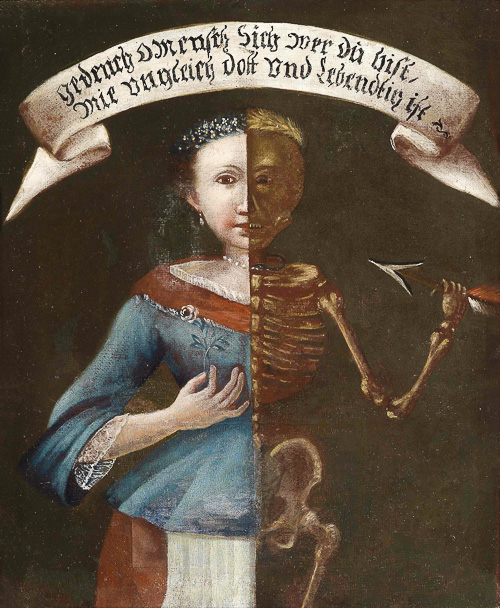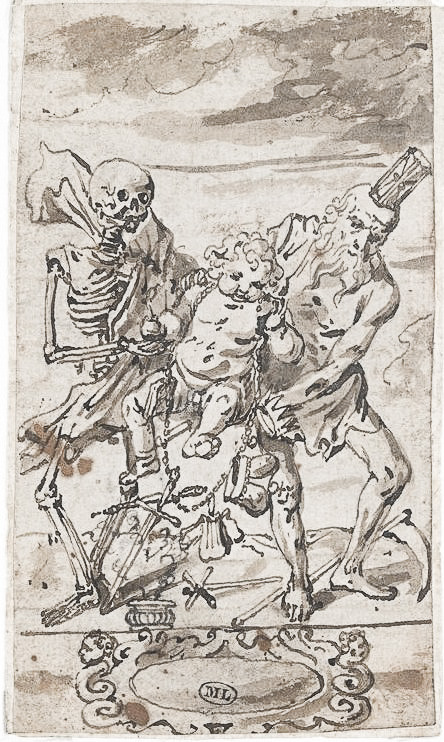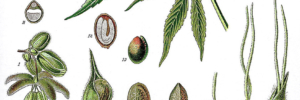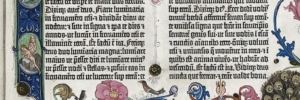.. of transience
Transience and beauty seem like a contradiction.
Isn’t it rather the case that beauty fades? Not at all. For it is the painfully beautiful transience of life and all things in it that first reveals their preciousness to us. The term vanitas already appears in the Old Testament: “Vanitas vanitatum, et omnia vanitas” means roughly: “It is all vain.” Vanitas can also be translated as futility, nothingness and empty talk.
Vanitas and Memento Mori –
gloomy beauties of bygone times
At first glance, therefore, the term itself does not seem to have much beauty in it. The vanitas motif was previously used predominantly in a moral-religious sense. It is closely related to memento mori – the commemoration of death – which was ubiquitous in the Middle Ages.
This morbid concept was intended to remind people to use their usually arduous and short lives to prepare for life in the afterlife – for only there could beauty be expected.
Thus, for people at that time, transience was more of a reminder and not an invitation to open up to the preciousness of earthly life.

Memento Mori. The banner above the figure says: „Gedenck Mensch sich wer Du bist/Wie ungleich Dott und Lebendig ist“, South German school of the 18th century, Dorotheum – Unknown author, Public domain, via Wikimedia Commons
Fascinating contrast
In the Baroque period, a little beauty finally entered this gloomy world of thought: Numerous painters discovered the fascination of the vanitas motif and combined the gloomy statement with magnificent painting.

Unknown French master, allegory of the vanity of earthly things, ~1630, Galleria Nazionale d’Arte Antica, Public domain, via Wikimedia Commons
They created masterful still lifes with beguiling colors and compositions that still fascinate today: Rotting fruit, moldy bread, and flies populate sumptuous table settings. Yet even though these paintings blended morbid skulls with marvelous painting technique to create a beguiling beauty, the morbid message remains:
Life is short, be obedient and prepare for the hereafter.
From today’s perspective, these admonitions seem unappealing and almost incomprehensible. In the course of the centuries, however, the church lost more and more of its influence – and the concept of vanitas also lost its educational significance and its raised forefinger.
Life is beautiful
Today, we think we are more free and enlightened – and supposed no longer need such reminders of transience. But the concept of vanitas can also be interpreted in a completely different way. Beyond medieval mind games, it can help to direct our gaze to earthly beauty.
For what is life without death? Only the knowledge of transience makes life attractive and precious. It is finiteness that shows us the true value of things. For life is short – too short for nothingness and empty talk.
But the vanitas concept shows even more: the beauty of transience can also be understood in terms of change. Thus, every end is also a kind of transformation. Every experience and every break are signs of transience and at the same time create something new.

The fragility of human life (vanitas), ~1630.1660, Collection Louvre Museum – David Ryckaert III, Public domain, via Wikimedia Commons


Uchikake mit roter Wolle auf Seidenbrokat gefilzt
From destruction comes art
When a piece of fabric is cut up with scissors and supposedly robbed of its pure beauty, it initially seems like pure destruction. But it is this process that allows a new thing to emerge. The pure fabric disappears and a piece of clothing emerges that has a completely new form and meaning: It decorates and warms and protects.
And the process of dyeing the light fabric is also a kind of transience. Irretrievably, the pigment penetrates the fibers – like dirt that destroys the original state. There is no going back. Oh, how beautiful it was before. So pure, so white – and yet also somehow boring and without history.
For when the pain of loss has subsided, there is something new, something unprecedented: only through the transformation process of cutting and coloring does a thing come into being that touches in a special way. For it is precisely this change that turns it into something living, something that has a new use – and through its experience of transience tells of life. And that is exactly what makes it precious and beautiful.
Change makes it precious
What is true for things is also true for life itself. Everything is loss and transformation at the same time. In Buddhism, anatta means that an unchanging, permanent self does not exist – anyway, nothing in life is permanent. Everything is constant change. Accordingly, the attempt to fix a state for eternity inevitably leads to suffering. Because simply nothing in this life can be fixed forever.
The fact that nothing lasts can be frightening at first. But this transience can also be comforting. Because it sharpens the view for the moment, for the essential and for what is right now. It shows us our own vulnerability and fragility. And it points out that only through a kind of destruction real life and art are possible. The essential comes to the fore. Everything vain, empty, and inane seems unimportant in the face of transience – because nothing remains forever anyway.
Vanitas can therefore also mean loving the process and not desperately clinging to things. Transience may not be beauty itself. But it has the power to sharpen the senses for the beauty of the moment, for the transformation in all things, and for what is essential.



















